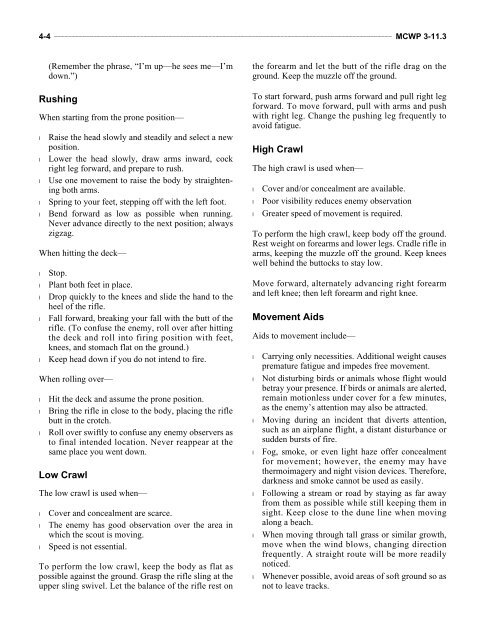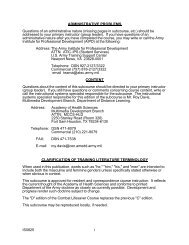MCWP-3-11.3-Scouting-and-Patrolling
MCWP-3-11.3-Scouting-and-Patrolling
MCWP-3-11.3-Scouting-and-Patrolling
You also want an ePaper? Increase the reach of your titles
YUMPU automatically turns print PDFs into web optimized ePapers that Google loves.
4-4 ______________________________________________________________________________________________ <strong>MCWP</strong> 3-<strong>11.3</strong>(Remember the phrase, “I’m up—he sees me—I’mdown.”)RushingWhen starting from the prone position—l Raise the head slowly <strong>and</strong> steadily <strong>and</strong> select a newposition.l Lower the head slowly, draw arms inward, cockright leg forward, <strong>and</strong> prepare to rush.l Use one movement to raise the body by straighteningboth arms.l Spring to your feet, stepping off with the left foot.l Bend forward as low as possible when running.Never advance directly to the next position; alwayszigzag.When hitting the deck—l Stop.l Plant both feet in place.l Drop quickly to the knees <strong>and</strong> slide the h<strong>and</strong> to theheel of the rifle.l Fall forward, breaking your fall with the butt of therifle. (To confuse the enemy, roll over after hittingthe deck <strong>and</strong> roll into firing position with feet,knees, <strong>and</strong> stomach flat on the ground.)l Keep head down if you do not intend to fire.When rolling over—l Hit the deck <strong>and</strong> assume the prone position.l Bring the rifle in close to the body, placing the riflebutt in the crotch.l Roll over swiftly to confuse any enemy observers asto final intended location. Never reappear at thesame place you went down.Low CrawlThe low crawl is used when—l Cover <strong>and</strong> concealment are scarce.l The enemy has good observation over the area inwhich the scout is moving.l Speed is not essential.To perform the low crawl, keep the body as flat aspossible against the ground. Grasp the rifle sling at theupper sling swivel. Let the balance of the rifle rest onthe forearm <strong>and</strong> let the butt of the rifle drag on theground. Keep the muzzle off the ground.To start forward, push arms forward <strong>and</strong> pull right legforward. To move forward, pull with arms <strong>and</strong> pushwith right leg. Change the pushing leg frequently toavoid fatigue.High CrawlThe high crawl is used when—l Cover <strong>and</strong>/or concealment are available.l Poor visibility reduces enemy observationl Greater speed of movement is required.To perform the high crawl, keep body off the ground.Rest weight on forearms <strong>and</strong> lower legs. Cradle rifle inarms, keeping the muzzle off the ground. Keep kneeswell behind the buttocks to stay low.Move forward, alternately advancing right forearm<strong>and</strong> left knee; then left forearm <strong>and</strong> right knee.Movement AidsAids to movement include—l Carrying only necessities. Additional weight causespremature fatigue <strong>and</strong> impedes free movement.l Not disturbing birds or animals whose flight wouldbetray your presence. If birds or animals are alerted,remain motionless under cover for a few minutes,as the enemy’s attention may also be attracted.l Moving during an incident that diverts attention,such as an airplane flight, a distant disturbance orsudden bursts of fire.l Fog, smoke, or even light haze offer concealmentfor movement; however, the enemy may havethermoimagery <strong>and</strong> night vision devices. Therefore,darkness <strong>and</strong> smoke cannot be used as easily.l Following a stream or road by staying as far awayfrom them as possible while still keeping them insight. Keep close to the dune line when movingalong a beach.l When moving through tall grass or similar growth,move when the wind blows, changing directionfrequently. A straight route will be more readilynoticed.l Whenever possible, avoid areas of soft ground so asnot to leave tracks.



